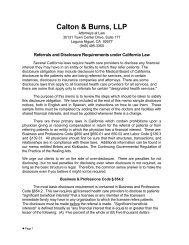Enhancing Your Practice's Revenue - California Orthopaedic ...
Enhancing Your Practice's Revenue - California Orthopaedic ...
Enhancing Your Practice's Revenue - California Orthopaedic ...
- No tags were found...
Create successful ePaper yourself
Turn your PDF publications into a flip-book with our unique Google optimized e-Paper software.
Section 5MarketingChapter 12Marketing in the Social Media AgeBy D. Kay Kirkpatrick, M.D and Richard J. LenzA physician cannot practice good medicine for long if heor she does not run a successful business. And, accordingto business guru Peter Drucker, “… Because the purposeof business is to create a customer, the business enterprisehas two — and only two — basic functions: marketing andinnovation. Marketing and innovation produce results; allthe rest are costs.”Here, Drucker’s definition of marketing was broad:basically, anything a business does to earn a customer (or,in the case of a physician practice, a patient). Withoutmarketing, no one knows what you have to offer. Withoutinnovation, your product and services lose ground to yourcompetition. Marketing is an ongoing function or process,not an event, and it plays a crucial role in the three pillarsof any strong business, especially in health care: customerrelations, operations, and innovations.Health care is big business, with one in 11 U.S. workersearning a living in this $2.5 trillion segment of the U.S.economy, which makes up 17.3 percent of U.S. GDP. Accordingto the Bureau of Labor Statistics, 7.2 million healthcare providers and technicians — of whom 690,000 arephysicians — earn $502 billion in wages.Over the past several decades, the practice of medicine— an essential and growing part of the U.S. economy —has experienced as much change as any other industry inAmerica. And the business of practicing medicine is themost complex, demanding, and regulated industry in theU.S., as any exhausted physician will testify.Doctors are forced to spend more and more time onbusiness aspects of their practice, and less and less timeon their original calling. Practices have not only had tokeep pace with the art and science of healing, but also dealwith changing technologies and government regulations,litigious patients and expensive staffing issues, while simultaneouslynavigating nonsensical and complex billing rulesfrom private and government payers. To survive and thrivein this ever-changing arena, physicians now find themselvesinvested in real estate developments, expensive technologies,and complex corporate structures.Into this mix comes a fresh consideration of the benefitsof marketing. Physicians have been among the last toadopt well-tested marketing approaches to their business.A discussion of marketing at a partnership meeting has thetone of a religious argument between believers and nonbelieversTraditionally, marketing has been misunderstoodas “unethical,” viewed as an unnecessary “luxury we can’tafford,” or delegated to administrative staff. It was the lastthing considered, if it was considered at all.Practice Marketing, Then and NowTypically, physician marketing in the broad sense consistedof peer-to-peer relationships generated by contact in thehospital, on boards, or at conferences. Sometimes, giftbaskets or lunches were sent during the holidays or ifsomeone new entered the community. “Getting aggressive”with their marketing, a practice would produce brochureswith their new and very complex logo plastered on thefront, and launch a career in publishing with a monthlypractice newsletter. The first issue would come outlate because no one had time to write the articles, andeventually the project would be dropped.Paid advertising occurred when looking to hire or toshow support for the local school. Occasionally, aftersomeone’s arm was twisted, a charitable event might besupported at the hospital or in the community. This meantthe practice logo was on a program or t-shirt with everyoneelse’s, and perhaps available and willing personnel wouldstaff a table with brochures and newsletters. Physicianswould attend the event only if it felt absolutely necessaryfor business reasons, given their hectic schedules and pressingfamily obligations. Does all this perhaps sound familiar?Today, health care is a competitive, fast-changing businesswith many factors at play, so you cannot afford to lettime and natural events build your reputation and success.You need to market to keep up with the competition.While old-school, peer-to-peer marketing is still the mostpowerful approach and should certainly not be abandoned,it is also the slowest and most time-consuming in ouralready over-tasked work day.More and more, health care is consumer-driven and lessreferral-driven, and patients desire and have been forced tohave more control over health care decisions, as you surelynotice when they come to your office with printouts andquestions gleaned from the Internet.Today, reputations are built using modern strategies,tactics, and tools such as market research and brand assessment,branding, web sites, social media and interactive40 © 2011 American Academy of <strong>Orthopaedic</strong> Surgeons
















